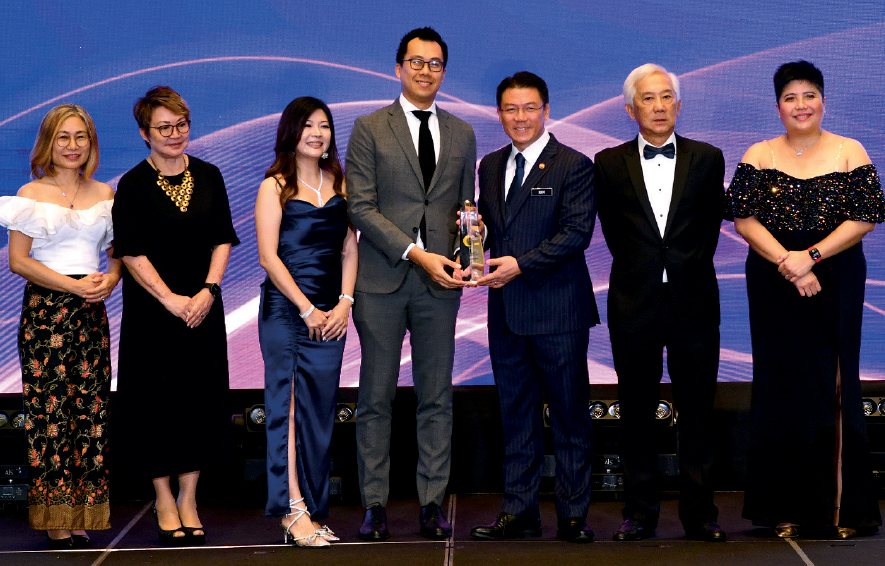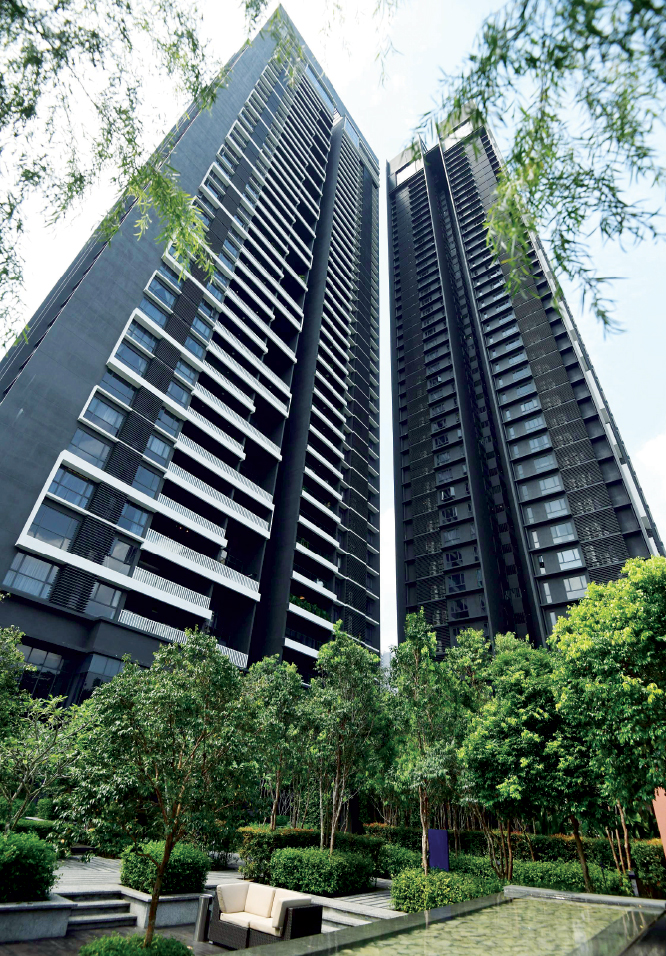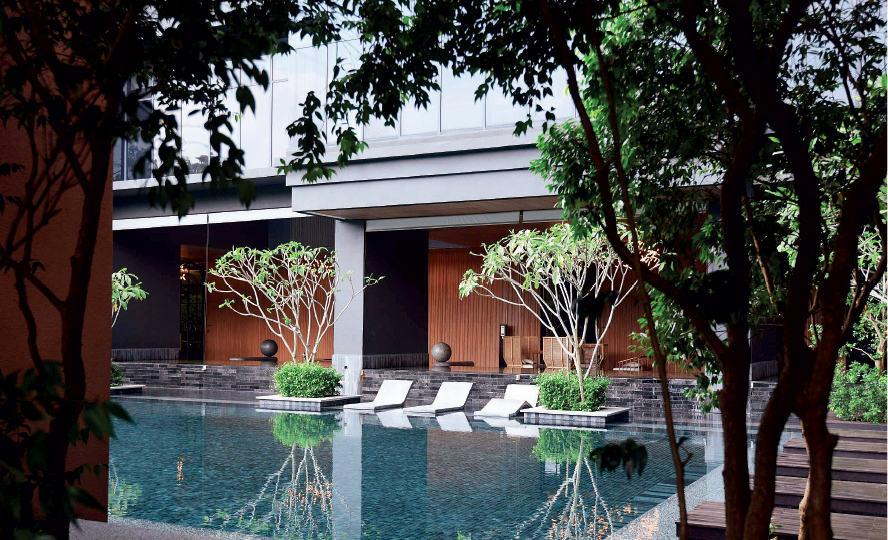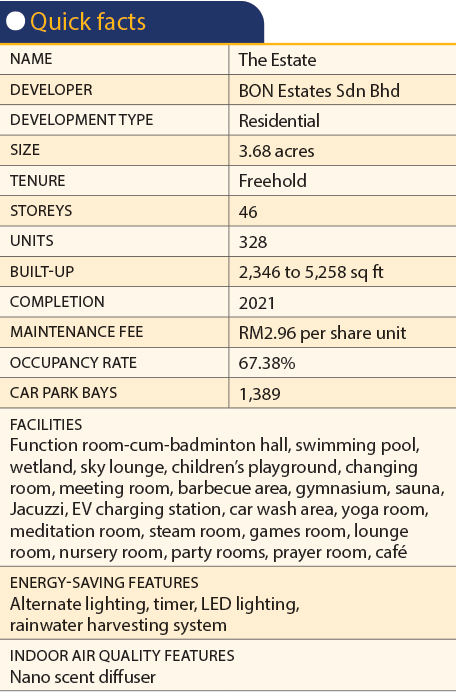This article first appeared in City & Country, The Edge Malaysia Weekly on July 17, 2023 - July 23, 2023

Although it is located in the lively area of Kerinchi, next to Bangsar South, The Estate exudes a sense of calmness and serenity. Perhaps it is the contemporary, elegant façade and dark exterior or the perfectly landscaped recreational areas of the condominium development that does the trick.
“From the front, The Estate looks like the keyboard of a piano. The façade is dark grey, which everyone was initially sceptical about, as a dark colour would make the building very hot. However, over time, that has changed because the unique colour makes The Estate stand out among the other high-rises in the area, and it’s not as hot as they expected because the project’s design allows plenty of natural ventilation,” BON Estates Sdn Bhd CEO Chan Jin-Wy tells City & Country in an interview.
Occupying a 3.68-acre freehold tract in Bangsar, Kuala Lumpur, The Estate comprises 328 condo units across two 46-storey towers. The built-ups of the units range from 2,346 to 5,258 sq ft. The facilities include a gymnasium, yoga room, sky lounge, function room, games room, meeting rooms, a multipurpose hall, children’s playground, Jacuzzi and swimming pools.
The Estate was completed in May 2021 and handed over to the owners in August 2021. BON Estates appointed Henry Butcher Malaysia (Mont Kiara) Sdn Bhd (HBMK) as its property manager in February 2021.
The Estate can now add another accolade to its collection of awards, having been selected the Gold winner in the Below 10 Years Multiple — owned Strata Residential category of The Edge Malaysia Best Managed & Sustainable Property Awards 2023.
Planning ahead
Chan says the developer started looking for a property manager even before The Estate was completed.
“We started discussing things casually at the end of 2020 and we spoke to many vendors. HBMK provided many good ideas by engaging and planning early, which helped us a lot because we were venturing into our maiden project. That experience and learning helped us strengthen the handover process,” he recalls, adding that HBMK’s partnership with The Estate started about seven months before the project’s vacant possession (VP).
HBMK managing director Low Hon Keong says that due to the increased awareness of property management, some developers prefer to engage with management companies before the VP.
“Many years ago, property management was often overlooked. In the past five years or so, there seems to have been an increased awareness of property management, as it affects a project’s value creation in the long run. For The Estate, the developer made the effort to set up meetings with us even before the VP to discuss maintenance and management plans,” Low adds.
HBMK associate director Jessie Koh Ching Nee elaborates, “We have provided input since the drafting of the by-laws, [which are the house rules of The Estate]. In terms of practicality, we have brought in the experience we gained from doing other developments and applied it to The Estate.

“We also advised on the renovation hours; sourcing of service providers, including security guards, cleaners and gardeners; setting up the management office such as the furniture and layout of the office; creating the accounting system; and submitting the [required] Form 25 to the Commissioner of Buildings (COB) as part of the strata management requirement for common area defects rectification. The Strata Management Act 2013 is quite new, which is why we worked with them on this.
“We worked together on the budget and the four-month advance billing, where we advised the developer to collect a deposit from owners for utilities such as electricity and water.”
For The Estate’s long-term maintenance and upkeep, Low says the management team uses the planned preventive maintenance (PPM) method, which is common practice in most condominiums.
“It essentially became the sole guide and reference in maintaining the building. As The Estate has many common facilities, the PPM should be integrated into the work scope of technicians on site.
“The preventive measures are to ensure the assets and facilities are maintained in the long run. Instead of corrective measures, we have preventive measures. As far as the maintenance of the facilities is concerned, we use PPM to schedule our weekly, monthly and yearly maintenance checklist.”
Every week, the management team checks on the development’s water features, swimming pool pump system as well as the common corridors’ staircase and lighting. Features that are checked monthly include the cold water pump system, pressure reducing valve, magnetic and door mechanism, main switchboard electrical equipment, Satellite Master Antenna Television system, surveillance system, access card system, lift system, fire fighting system, fire alarm panel system, bomba intercom system and generator set. The water tanks are checked once a year.
Low says, “With long-term preventive maintenance, we get to prolong the lifespan of the facilities and they will last longer than was initially expected. That would also help us save on the sinking fund and expenditure.”
Cost-saving initiatives
The maintenance fee for The Estate is RM2.96 per share unit. Koh says the collection rate has been healthy and maintained at 99%. She adds that the development has been fully sold and the occupancy rate is currently 67.38% for both towers.
According to Chan, The Estate has been able to achieve a strong collection rate because it is mostly owner-occupied. “If you sell a residential development and it is mostly occupied, people tend to pay their maintenance fee.”
Meanwhile, Koh says that The Estate’s actual amount spent was slightly lower than what was budgeted in 2022. One of the reasons is due to the extra income from fixed deposit interest, facilities income and the sale of access cards.
The overall expenditure variance was underspent by 23%, the contractual operating expenditure was underspent by 15%, non-contractual operating expenditure was underspent by 57%, utility charges were underspent by 8% and administrative expenditure was underspent by 22%.
“From our previous budget, we saw that we could sustain the sinking fund for the next five years. So far, we have not used the sinking fund at all. This [shows] how important the selection of materials is for a development. For The Estate, it’s safe to say that over 80% of the materials used are of high quality, which makes them durable and long-lasting,” says Koh.
Chan concurs, saying: “The project team and shareholders themselves have contributed to choosing all the right materials. We even curated the landscape very carefully.
“We went back to the fundamentals of landscaping, that is, the selection of plants, which is very important in terms of maintenance. We can’t afford to have plants that need to be taken care of every single day. The plants that were chosen are also suitable for our tropical weather; so, they are easier to maintain and will live longer.”
Of the development’s energy-saving features, Chan says The Estate’s energy and cost-saving ideas came into play during the planning stage of the development. “The design of The Estate in this sense is that all the lighting features use LED lighting, abandoning the usage of conventional light bulbs.”
Koh explains, “LED lighting uses much less energy to provide the same amount of light. Using less energy translates into producing less heat. LED lighting also has a longer lifespan than traditional incandescent bulbs. As a result, the management is able to save a lot of money or cut down on electrical expenses.”
Another energy-saving initiative undertaken by HBMK is the use of timers in areas that are not commonly used by residents. “For example, in some areas that do not require lighting because there is enough natural light coming in, the lights are turned on only when it gets dark, from 7pm until the next morning,” says Koh.
Besides energy-saving features, The Estate optimises cost through its rainwater harvesting system, which collects rainwater and stores it in a tank to be used later for numerous purposes.
“At The Estate, the collected rainwater is primarily used by the gardeners for the landscape. Given the abundance of plants and other greenery, the water consumption is significant. So, it is important to have a rainwater harvesting system to support the condominium’s water usage,” says Koh.
In terms of challenges, he cites, for example, the defects liability period (DLP) for The Estate, which will expire in September this year.
“We are still under the DLP. Now may not be the right time to implement some of the energy-saving measures that we have planned because it could tamper with the system, causing the DLP to be null and void.
“That’s the limitation we have but we’re working on a comprehensive plan for things that can be implemented upon the expiry of the DLP. We’ve listed all the assets and equipment that can be upgraded right after it expires.”
Value creation
As long as maintenance work is carried out to ensure that The Estate lasts a long time, the chances are high that the condo units will enjoy a higher resale value.
Chan says the units were sold around RM600 psf when the project was launched in 2017. Today, they are valued at more than RM900 psf. “That’s a capital appreciation of more than 50%. The current rental yield of 6% to 7% is usually seen in commercial properties. That is evidence of how maintenance can contribute to a property’s value creation. As long as we work to ensure the building and its features last a long time, we will be able to see the property prices rise.”
Save by subscribing to us for your print and/or digital copy.
P/S: The Edge is also available on Apple's App Store and Android's Google Play.
- SumiSaujana slumps on ACE Market, on course to be worst IPO debut
- Stocks tumble again as US hits China with 104% tariffs, Treasuries slammed
- US slaps higher taxes on small parcels in tit-for-tat trade war
- How Trump's policy risk is showing in Treasury bonds
- US stocks take another roller coaster ride on US-China threats
- Edunation: Enhancing STEM education a strategic imperative for the nation’s future
- Lawyer files legal challenge against the Judicial Appointments Commission’s power to appoint judges, wants law allowing it deemed unconstitutional
- Reach Ten pushes ahead with Main Market IPO, first Sarawak firm listing in 15 years
- Stocks tumble again as US hits China with 104% tariffs, Treasuries slammed
- SumiSaujana to stay the course on overseas expansion amid global trade war fears — chairman




